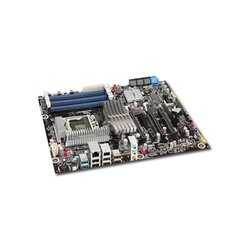Hi Everyone,
Either I am not proficient with the forum's search feature or i'm simply not finding it, I had a quick question about static pressure relevance in the orientation of a fan.
Im in the market for getting another 60mm fan to hang on the front of my board's IOH heatsink, as the one I am using now used to sit atop a heatsink for a Pentium III processor (oh memories), and runs rather fast and loud at it's 4000 to 6000 rpm range (i am not exaggerating this number.). I'd like to get something a little quieter, and of course my cup runneth over when it comes to choices. Having recently done a lot of research into fans with the best static pressure, I couldn't help but ask: is this a situation where static pressure is a better bench mark than a CFM count? I have attached an image to this post so you can see what heatsink I am tying this fan to - it's the large aluminum one right in the center of the board.
Any opinion you guys can give me would be greatly appreciated, as I simply want to get my cooling solution 'right.' Thanks!
Either I am not proficient with the forum's search feature or i'm simply not finding it, I had a quick question about static pressure relevance in the orientation of a fan.
Im in the market for getting another 60mm fan to hang on the front of my board's IOH heatsink, as the one I am using now used to sit atop a heatsink for a Pentium III processor (oh memories), and runs rather fast and loud at it's 4000 to 6000 rpm range (i am not exaggerating this number.). I'd like to get something a little quieter, and of course my cup runneth over when it comes to choices. Having recently done a lot of research into fans with the best static pressure, I couldn't help but ask: is this a situation where static pressure is a better bench mark than a CFM count? I have attached an image to this post so you can see what heatsink I am tying this fan to - it's the large aluminum one right in the center of the board.
Any opinion you guys can give me would be greatly appreciated, as I simply want to get my cooling solution 'right.' Thanks!



 , but I just can't get something like that to fit. (I think)
, but I just can't get something like that to fit. (I think)